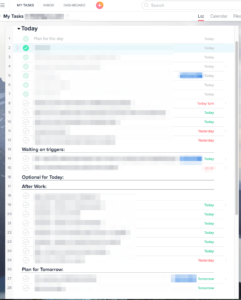 I have been looking for personal task tracking systems for a while. I ended up trying a few of the expected ones like simple lists in OneNote and Wunderlist. I was hoping to find something that was simple to get started with, but also had enough features to make it effective.
I have been looking for personal task tracking systems for a while. I ended up trying a few of the expected ones like simple lists in OneNote and Wunderlist. I was hoping to find something that was simple to get started with, but also had enough features to make it effective.
While looking for a task tracking solution for a new project that involved multiple participants I stumbled upon Asana. The value proposition made sense for our needs so we decided to try it out. After a few weeks of using the system to track tasks for the team, I, unconsciously, started tracking more and more of my personal tasks in Asana.
The project that I was using it for came to an end, but my use of Asana for personal task tracking has continued. I was able to find a layout and create a daily workflow that works pretty good for me. Below you can see a blurred out screenshot of the “My Tasks” screen that shows how I have divided it into sections.

I want to point out a few things on this screenshot. First, note the “Plan for the day” task at the top of my list. I created this as a daily recurring task and I always try to do it as the first thing.
Second, note that my daily view includes both the completed tasks and the incomplete/upcoming ones. I don’t have a specific article link handy right now, but the completed ones are basically there for positive reinforcement throughout the day. I am always happy to see my progress throughout the day, and especially at the end of the day. Asana actually goes a step further to make task completion fun by randomly showing a “celebration” when you complete tasks (check out the link for an animated example).
Third, I created a few sections for properly dividing up my tasks throughout the day. In my case, I settled on the following sections.
- Tasks above the “Waiting on triggers” section – These are my prioritized tasks that I plan to get done for sure on a given day/time. As you can see in the screenshot, I don’t always end up completing all the tasks, but that’s the goal.
- Waiting on triggers – These are tasks where I might be waiting on others. For example, if someone was supposed to schedule a meeting that day, I put it as a reminder here. Many times these also live as emails and other things, but I have found that my duplication is more effective than using multiple systems. You can use Asana’s email to task functionality to make this easier.
- Optional for Today – This one is self-explanatory.
- After Work – Again, self-explanatory.
- Plan for Tomorrow – Depending on how much time I have left at the end of the day I might plan the next day, and this is where those tasks start. The following day I manually move these to the top and re-prioritize, if necessary.
There are other sections like Upcoming and Later that Asana provides out of the box, but I have learned that it’s cleaner to keep those hidden on the My Tasks screen. Every night Asana automatically moves new tasks from the Upcoming/Later sections to the Plan for Tomorrow section. This way, if I set properly set the due dates on the tasks, new tasks automatically show up in the right place ready to be prioritized the following day.
A system can only be as good as the users of the system want it to be. So, whatever system you might have, the key is to actually follow it consistently.
Now that I am ready to publish this post, I am going to go happily mark my “Blog – Asana for personal task tracking” task as complete!
